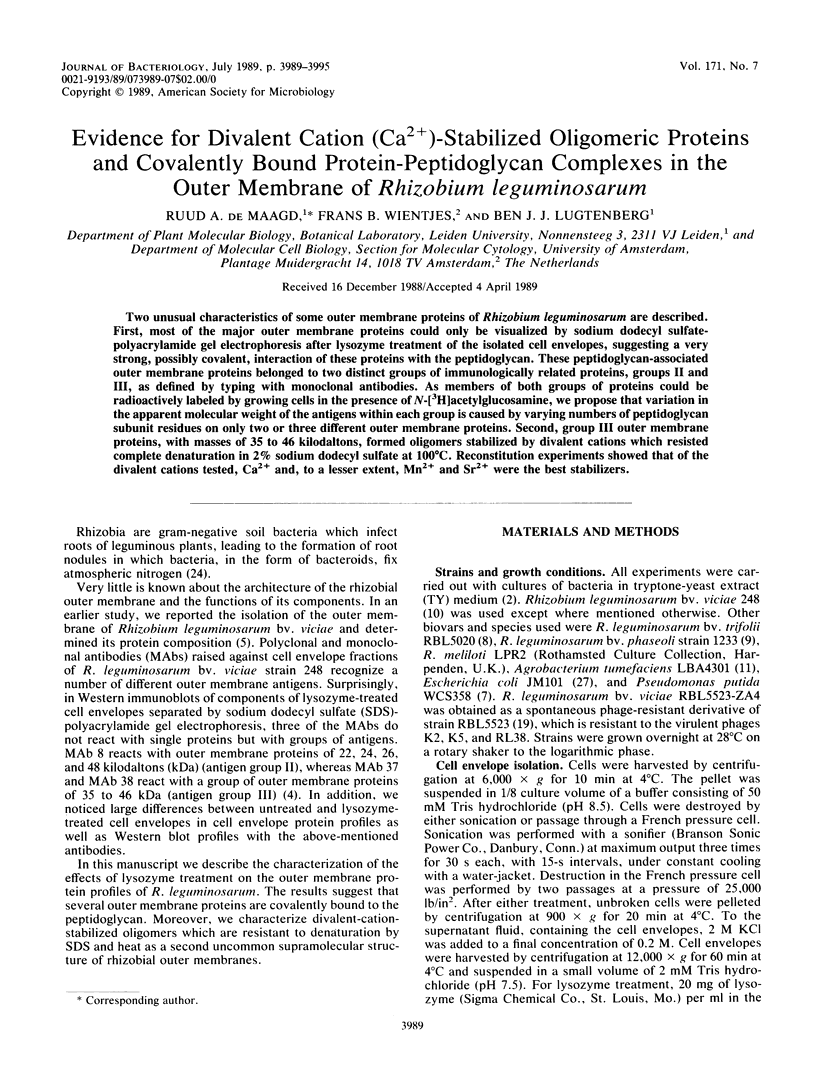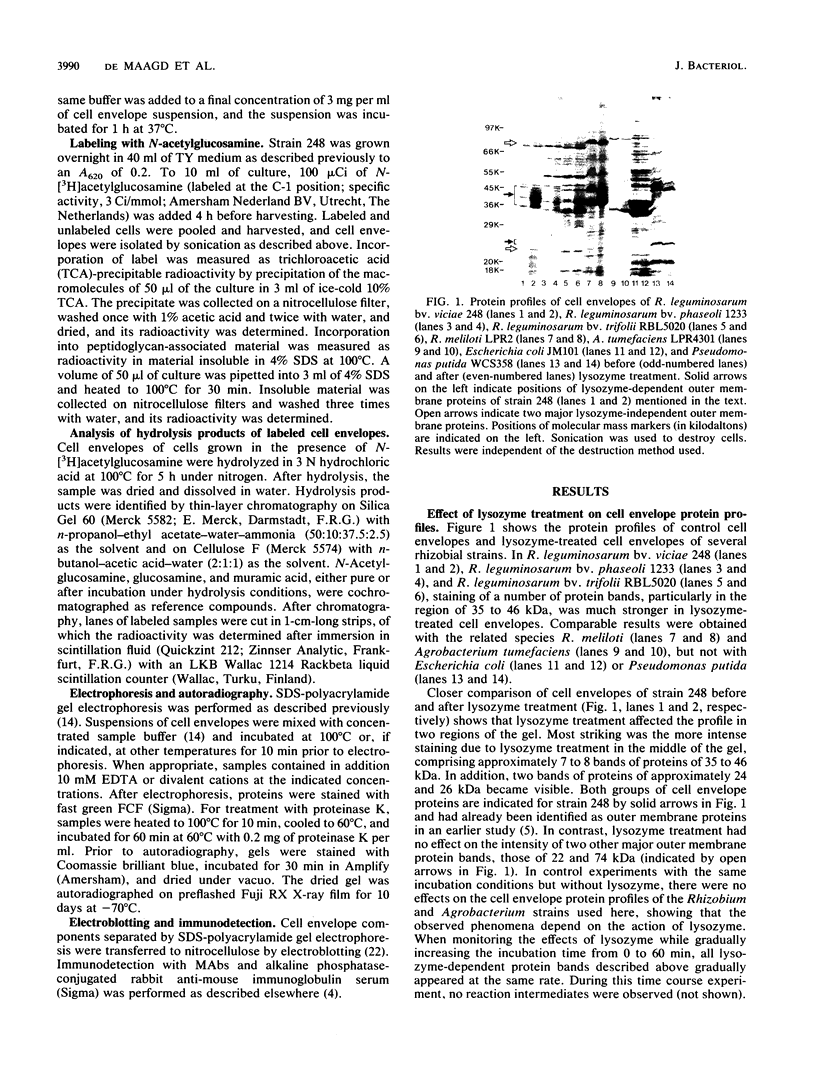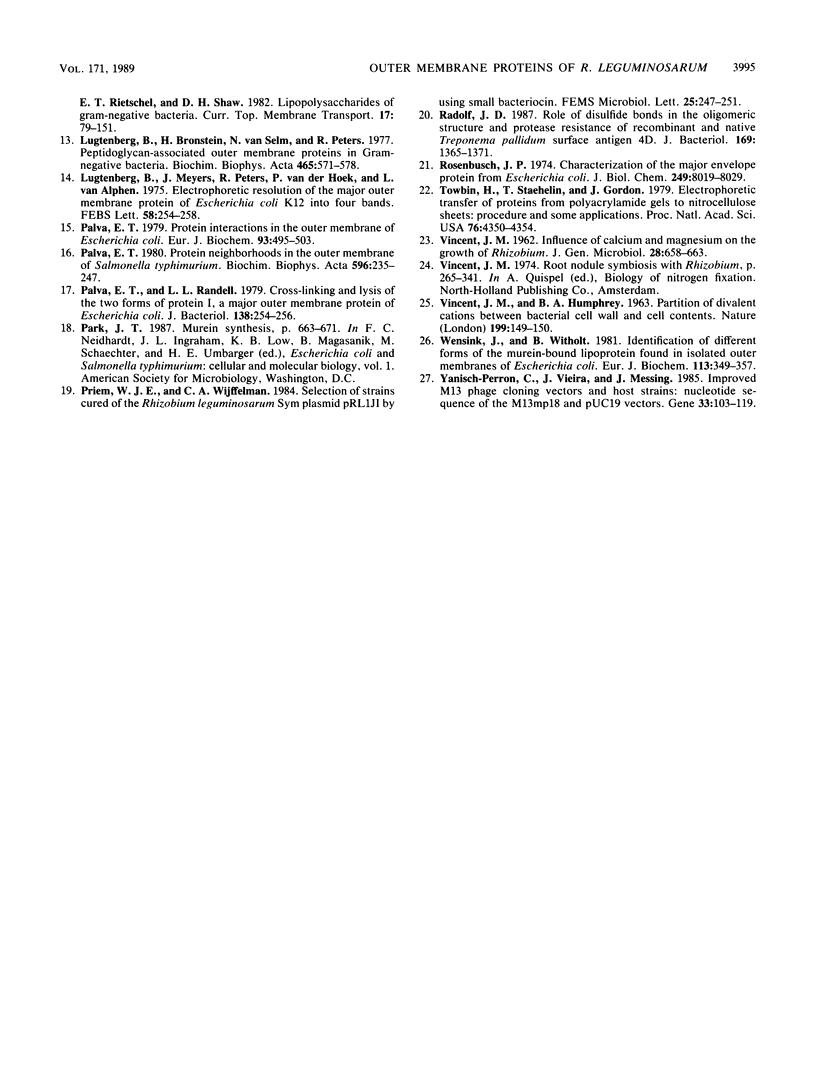Abstract
Two unusual characteristics of some outer membrane proteins of Rhizobium leguminosarum are described. First, most of the major outer membrane proteins could only be visualized by sodium dodecyl sulfate-polyacrylamide gel electrophoresis after lysozyme treatment of the isolated cell envelopes, suggesting a very strong, possibly covalent, interaction of these proteins with the peptidoglycan. These peptidoglycan-associated outer membrane proteins belonged to two distinct groups of immunologically related proteins, groups II and III, as defined by typing with monoclonal antibodies. As members of both groups of proteins could be radioactively labeled by growing cells in the presence of N-[3H]acetylglucosamine, we propose that variation in the apparent molecular weight of the antigens within each group is caused by varying numbers of peptidoglycan subunit residues on only two or three different outer membrane proteins. Second, group III outer membrane proteins, with masses of 35 to 46 kilodaltons, formed oligomers stabilized by divalent cations which resisted complete denaturation in 2% sodium dodecyl sulfate at 100 degrees C. Reconstitution experiments showed that of the divalent cations tested, Ca2+ and, to a lesser extent, Mn2+ and Sr2+ were the best stabilizers.
Full text
PDF






Images in this article
Selected References
These references are in PubMed. This may not be the complete list of references from this article.
- Berenguer J., Faraldo M. L., de Pedro M. A. Ca2+-stabilized oligomeric protein complexes are major components of the cell envelope of "Thermus thermophilus" HB8. J Bacteriol. 1988 Jun;170(6):2441–2447. doi: 10.1128/jb.170.6.2441-2447.1988. [DOI] [PMC free article] [PubMed] [Google Scholar]
- Beringer J. E. R factor transfer in Rhizobium leguminosarum. J Gen Microbiol. 1974 Sep;84(1):188–198. doi: 10.1099/00221287-84-1-188. [DOI] [PubMed] [Google Scholar]
- Braun V. Covalent lipoprotein from the outer membrane of Escherichia coli. Biochim Biophys Acta. 1975 Oct 31;415(3):335–377. doi: 10.1016/0304-4157(75)90013-1. [DOI] [PubMed] [Google Scholar]
- Hooykaas P. J., Snijdewint F. G., Schilperoort R. A. Identification of the Sym plasmid of Rhizobium leguminosarum strain 1001 and its transfer to and expression in other rhizobia and Agrobacterium tumefaciens. Plasmid. 1982 Jul;8(1):73–82. doi: 10.1016/0147-619x(82)90042-7. [DOI] [PubMed] [Google Scholar]
- Klapwijk P. M., van Beelen P., Schilperoort R. A. Isolation of a recombination deficient Agrobacterium tumefaciens mutant. Mol Gen Genet. 1979 Jun 7;173(2):171–175. doi: 10.1007/BF00330307. [DOI] [PubMed] [Google Scholar]
- Lugtenberg B., Bronstein H., van Selm N., Peters R. Peptidoglycan-associated outer membrane proteins in gammegatine bacteria. Biochim Biophys Acta. 1977 Mar 17;465(3):571–578. doi: 10.1016/0005-2736(77)90274-7. [DOI] [PubMed] [Google Scholar]
- Lugtenberg B., Meijers J., Peters R., van der Hoek P., van Alphen L. Electrophoretic resolution of the "major outer membrane protein" of Escherichia coli K12 into four bands. FEBS Lett. 1975 Oct 15;58(1):254–258. doi: 10.1016/0014-5793(75)80272-9. [DOI] [PubMed] [Google Scholar]
- Palva E. T. Protein interactions in the outer membrane of Escherichia coli. Eur J Biochem. 1979 Feb 1;93(3):495–503. doi: 10.1111/j.1432-1033.1979.tb12848.x. [DOI] [PubMed] [Google Scholar]
- Palva E. T. Protein neighborhoods in the outer membrane of Salmonella typhimurium. Biochim Biophys Acta. 1980 Feb 28;596(2):235–247. doi: 10.1016/0005-2736(80)90358-2. [DOI] [PubMed] [Google Scholar]
- Palva E. T., Randall L. L. Cross-linking analysis of the two forms of protein I, a major outer membrane protein of Escherichia coli. J Bacteriol. 1979 Apr;138(1):254–256. doi: 10.1128/jb.138.1.254-256.1979. [DOI] [PMC free article] [PubMed] [Google Scholar]
- Radolf J. D., Borenstein L. A., Kim J. Y., Fehniger T. E., Lovett M. A. Role of disulfide bonds in the oligomeric structure and protease resistance of recombinant and native Treponema pallidum surface antigen 4D. J Bacteriol. 1987 Apr;169(4):1365–1371. doi: 10.1128/jb.169.4.1365-1371.1987. [DOI] [PMC free article] [PubMed] [Google Scholar]
- Rosenbusch J. P. Characterization of the major envelope protein from Escherichia coli. Regular arrangement on the peptidoglycan and unusual dodecyl sulfate binding. J Biol Chem. 1974 Dec 25;249(24):8019–8029. [PubMed] [Google Scholar]
- Towbin H., Staehelin T., Gordon J. Electrophoretic transfer of proteins from polyacrylamide gels to nitrocellulose sheets: procedure and some applications. Proc Natl Acad Sci U S A. 1979 Sep;76(9):4350–4354. doi: 10.1073/pnas.76.9.4350. [DOI] [PMC free article] [PubMed] [Google Scholar]
- VINCENT J. M., HUMPHREY B. A. PARTITION OF DIVALENT CATIONS BETWEEN BACTERIAL WALL AND CELL CONTENTS. Nature. 1963 Jul 13;199:149–151. doi: 10.1038/199149a0. [DOI] [PubMed] [Google Scholar]
- VINCENT J. M. Influence of calcium and magnesium on the growth of rhizobium. J Gen Microbiol. 1962 Sep;28:653–663. doi: 10.1099/00221287-28-4-653. [DOI] [PubMed] [Google Scholar]
- Wensink J., Witholt B. Identification of different forms of the murein-bound lipoprotein found in isolated outer membranes of Escherichia coli. Eur J Biochem. 1981 Jan;113(2):349–357. doi: 10.1111/j.1432-1033.1981.tb05073.x. [DOI] [PubMed] [Google Scholar]
- Yanisch-Perron C., Vieira J., Messing J. Improved M13 phage cloning vectors and host strains: nucleotide sequences of the M13mp18 and pUC19 vectors. Gene. 1985;33(1):103–119. doi: 10.1016/0378-1119(85)90120-9. [DOI] [PubMed] [Google Scholar]
- de Maagd R. A., Lugtenberg B. Fractionation of Rhizobium leguminosarum cells into outer membrane, cytoplasmic membrane, periplasmic, and cytoplasmic components. J Bacteriol. 1986 Sep;167(3):1083–1085. doi: 10.1128/jb.167.3.1083-1085.1986. [DOI] [PMC free article] [PubMed] [Google Scholar]
- de Maagd R., de Rijk R., Mulders I. H., Lugtenberg B. J. Immunological characterization of Rhizobium leguminosarum outer membrane antigens by use of polyclonal and monoclonal antibodies. J Bacteriol. 1989 Feb;171(2):1136–1142. doi: 10.1128/jb.171.2.1136-1142.1989. [DOI] [PMC free article] [PubMed] [Google Scholar]
- de Maagd R., van Rossum C., Lugtenberg B. J. Recognition of individual strains of fast-growing rhizobia by using profiles of membrane proteins and lipopolysaccharides. J Bacteriol. 1988 Aug;170(8):3782–3785. doi: 10.1128/jb.170.8.3782-3785.1988. [DOI] [PMC free article] [PubMed] [Google Scholar]
- de Weger L. A., van Boxtel R., van der Burg B., Gruters R. A., Geels F. P., Schippers B., Lugtenberg B. Siderophores and outer membrane proteins of antagonistic, plant-growth-stimulating, root-colonizing Pseudomonas spp. J Bacteriol. 1986 Feb;165(2):585–594. doi: 10.1128/jb.165.2.585-594.1986. [DOI] [PMC free article] [PubMed] [Google Scholar]









